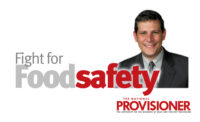Supplier's Perspective: Thermo Fisher Scientific
Manufacturing operations must prevent foreign bodies from making their way into food

Opening image credit: GettyImages / gorodenkoff / iStock Plus / Getty Images Plus
The presence of bacteria, heavy metals, and allergens in food can have widespread and devastating effects on consumer health. However, it is not just microscopic contaminants that can cause harm to the public. Manufacturing operations must also prevent foreign bodies from making their way into foodstuffs to safeguard consumer safety and avoid the reputational damage that can accompany instances of contamination. This highlights the importance of employing comprehensive quality control protocols in food production environments to identify and remove hazardous stowaways before they can reach the market.
Common causes
It is usually discoveries of particularly bizarre or disturbing objects that end up gaining the most media attention. However, the majority of foreign bodies found in food tend to be more run-of-the-mill, such as pieces of plastic or metal and can originate from a wide range of sources. Contaminants can enter the product line through the harvesting of raw ingredients where it is relatively common for objects like stones to be scooped up and bagged along with the product. Heavy operations like mixing and grinding can cause pieces of worn machinery components to break off into the process line, and it is not unheard of for personal objects such as jewelry, PPE, or pocket contents of line workers to accidentally make their way onto the conveyor. On top of this, errors during the packaging process can lead to errant pieces of plastic, foil, cardboard, or cellophane contaminating the product.
The U.S. Department of Agriculture and the U.S. Food and Drug Administration both publish strict guidelines aimed at preventing product contamination with these items in order to avoid risks to the public, such as choking, oral cavity damage, or perforation of the gastrointestinal tract. However, in the unfortunate event of a foreign object being discovered by a consumer, a full recall of all affected products may be required at great financial and reputational cost to the manufacturer.
Detect and discard
The two most established technologies used to prevent such incidents in the food and beverage industry are X-ray scanners and metal detectors. Metal detectors use electromagnetic induction to interact with — and alert users to the presence of — highly conductive contaminants, making them suited to the identification of metal objects. However, food products with significant moisture or salt content — like those commonly involved in meat and poultry processing — may lead to false positives based on their high conductivity, warning operators of metal contaminant issues when, in fact, none exist. However, this “product effect” can be overcome by employing multifrequency technologies and dedicated software packages, which drastically increase detection sensitivity while reducing the number of false alarms.
X-ray systems can detect a much wider range of contaminants — including metal, glass, and bone fragments — using density variations to pinpoint objects that should not be there. Unlike metal detectors that are unable to “see through” products encased in foil packing, X-ray scanners are suited to final packaging checks, as they are able to penetrate metallic containers to generate a picture of the contents within. However, because these systems rely on density variations to differentiate contaminants from their surroundings, some objects can effectively become invisible if they are similar in density to the product being inspected.
Conclusion
Quality control is clearly an essential part of a robust food and beverage processing operation, as failure to prevent contamination can have serious consequences for consumers and producers alike. Fortunately, X-ray scanners and metal detectors can identify the presence of foreign objects in foodstuffs, and many manufacturers choose to adopt a belt‑and‑braces approach by employing both solutions to gain extra degrees of confidence. After all, in today’s world, it only takes one viral social media post about a contaminated product to leave a whole customer base with a bitter taste.
Luca Bertona is EMEA sales manager at Thermo Fisher Scientific.
Looking for a reprint of this article?
From high-res PDFs to custom plaques, order your copy today!








